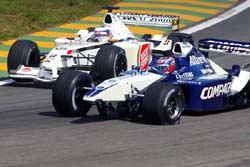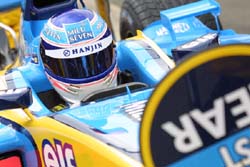
Of course the purists, looking through rose-tinted spectacles some say, will describe races from a bygone era where the lead changed hands three times every lap, as firm-jawed, smoky-faced heroes engaged in epic duels.
By contrast those who were brought up on modern Formula One describe the thrill of the chase, saying that the anticipation is as important as the move itself. They will make the comparison between American football and European soccer. One has dozens of points and the other will often have only the odd goal. But both can be thrilling entertainment.
It was only two seasons and a half ago that Juan Pablo Montoya announced his arrival with a manoeuvre on world champion Michael Schumacher in Brazil when he went sliding in from an impossible distance approaching the Senna S and muscled through into the lead. He did not win the race, or indeed any other for several months, but he emerged from the car to a standing ovation and his F1™ reputation was made there and then.
Then he proved it was no fluke by repeating the feat on the world's top driver twice in the course of the season. His Brazilian move was a high risk manoeuvre - literally using Schumacher's car to 'lean on' as he raced in from a distance that caught even the champion by surprise.
"I thought he was too far behind to try anything," admitted Schumacher afterwards. So stunned was he by what had happened that he turned to his team in the months to come and they used the live television pictures to watch his behind.
The way modern F1 cars are built is also a factor in the equation that makes overtaking far less frequent than it used to be: the cars' suspension struts cannot take more than a slight knock - if it is in a direction they were not designed to cope with. They are built to do their job, take the required vertical loads and be as aerodynamically efficient as possible. Withstanding collisions is not in the design brief.
At the start of this year David Coulthard actually admitted his McLaren had been "beefed up" specifically to take any possible contacts that might occur. Unfortunately he has rarely got that close.
With more than the slightest tap having potentially disastrous consequences, drivers often choose to settle for a certain eight points rather than a possible ten. The stakes in what is a multi-million pound sport are just too high.
But it's impossible to argue against the fact that 2002 has not seen as much action as we did, say 30 years ago. With Ferrari clearing off into the distance at almost every race last year, it seems pointless to bemoan the fact that you can't overtake in the sport any more. The likes of Williams and McLaren certainly won't get past Ferrari if they can't get near them. No-one can blame Ferrari for that. You can't criticise someone for being too good. Nevertheless, popular opinion still says that the modern breed of F1 car makes overtaking close to impossible to overtake. So what's the real story and how can the situation be improved?
This year, unlike last season, Montoya no longer has a huge BMW power advantage propelling him down the straights. Hence he, like the rest, has struggled to put in many overtaking moves.
"With a big performance advantage, it's not so difficult to overtake," says
Montoya. "But if you're in the same conditions it's nearly impossible. You can
be a second a lap quicker and you can really only do it if a guy ahead makes a
mistake."

The difference in pace that you need to have in order to get past is so big that even a 2002 Ferrari that starts from the back of the field begins to struggle when it makes it into the top ten. Renault's Jenson Button managed to keep Rubens Barrichello behind him at last year's British Grand Prix simply because the difference in pace wasn't big enough.
"Usually if people like Ferrari are coming through the field, they're in a different league, so they can overtake," says Button. "But as soon as they come up behind someone like us, a relatively quick car, even they find it difficult. At Silverstone Barrichello got past everyone else, but then he was behind me and he couldn't get past - even though he was one and a half seconds quicker."
The problem is not the drivers. They are no less courageous than their predecessors - more technically brilliant if anything - it is the cars. Aerodynamics is the god of the current race machine. The car's sport delicate aerodynamic balances between front and back with numerous little twists and turns of wings, endplates and bargeboards feeding the air from front to back - each one treading the delicate balance between downforce and loss of speed. Just like the normal road car, direction comes from the front wheels and they are kept on the ground by the pressure created by the front wings. They are effectively like an upside down plane wing. On an aircraft you need speed for lift. On an F1 car you use it for downward pressure, ie grip or "downforce" as the engineers and drivers term it.
But every car has a desperate need for grip from the rear tyres too, hence the huge wings on the back. And this is where the problem arises; at speed the rear wing creates a low pressure area behind it. So a rival surges up behind into the low pressure area but then loses vital grip on the front of their car. No air flow equals no downforce or grip. Suddenly the front wheels go 'light' on the driver (imagine driving on ice) and when the wheel is turned to dodge past his rival, nothing happens.
Check back soon for the second and concluding part of this feature. Find out how modern circuit design effects overtaking and what the drivers think could be done to increase the amount of passing in F1 racing.